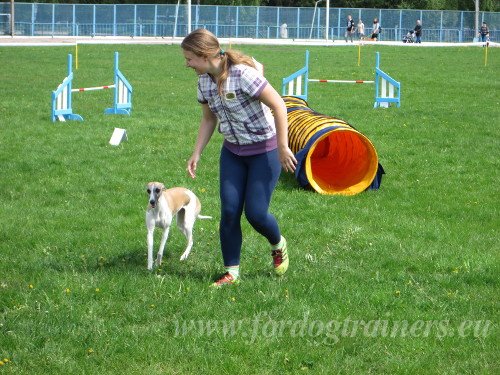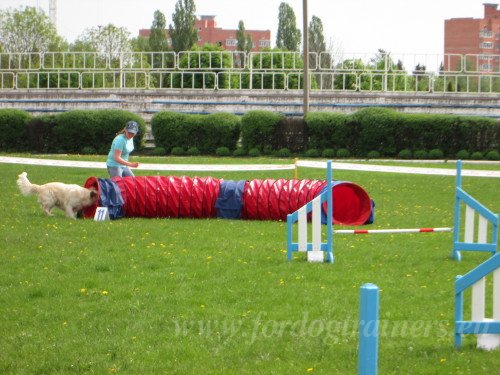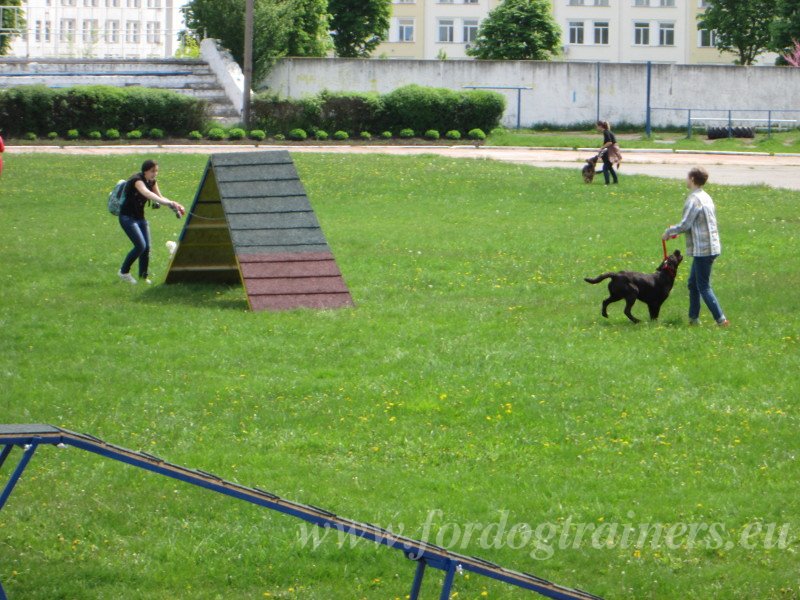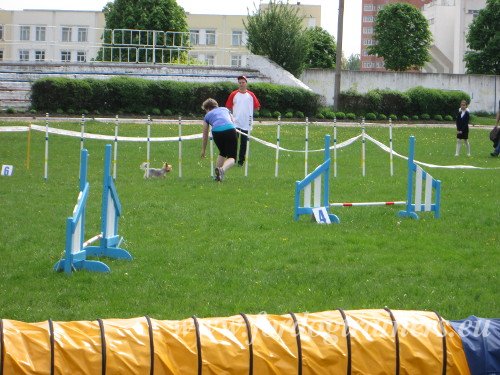|
|
Dog Agility General Information
What is DOG AGILITY and Its General Rules Dog
Agility is
the sport
in which a
dog, led by handler, overcomes
various obstacles mainly
on speed and accuracy.
The results of these competitions are
scored after the
dog passes
two tracks. On
the first track obstacles
with touch zones are located, for example
dogwalk, A-frame,
see-saw, and
pause table. The
second track is a jumping one
without touching zones and stop. Agility is
a sport for heated
people and cheerful dogs.
Agility
General Information
The main task in
Agility looks
simple and clear
– to run the
track faster than all the others,
overcoming various obstacles. The
difficulty is
that a
handler can
only guide his
dog using voice and gestures.
 Touching dogs and obstacles
is prohibited, dogs should wear no collars.
An arrangement of obstacles
on the track is
unknown until the competition
starts.
Judge allows handlers
to get acquainted with the track for a few minutes before the
beginning of the
competition – to make a “walk-through”.
Besides, handlers are provided with “course
maps”. The
dog is not familiar with the tracks,
and proceeds
around the course right away.
Touching dogs and obstacles
is prohibited, dogs should wear no collars.
An arrangement of obstacles
on the track is
unknown until the competition
starts.
Judge allows handlers
to get acquainted with the track for a few minutes before the
beginning of the
competition – to make a “walk-through”.
Besides, handlers are provided with “course
maps”. The
dog is not familiar with the tracks,
and proceeds
around the course right away.
Obstacles
in Agility
The
dog should properly overcome about 20
different obstacles
(jumps,
tire
jump,
tunnels, weave
poles,
etc.). For knocking
down a bar and other possible course
faults a dog gets penalty points, which can
render the speed
advantage null.  In
Agility the dog owner learns to understand the dog, to communicate
with it, as in any other dog sport. The dog learns to be confident
and to overcome what it does not see, for example, curved
tunnel. Second, it learns to trust the handler, it knows he
will never set a goal the dog can not reach. Weaving poles is
probably the most difficult obstacle in agility. But at the same time
the most effective, if the dog learns to run it well.
In
Agility the dog owner learns to understand the dog, to communicate
with it, as in any other dog sport. The dog learns to be confident
and to overcome what it does not see, for example, curved
tunnel. Second, it learns to trust the handler, it knows he
will never set a goal the dog can not reach. Weaving poles is
probably the most difficult obstacle in agility. But at the same time
the most effective, if the dog learns to run it well.
The
See-saw is one of the most difficult obstacles as well. The
dog should not only
touch the contact zone, but also move. This is the most complicated
for the dog does
not know when it should start to move. It should understand what kind
of obstacle it
is, how it works and what it should do to overcome it.
 The dog
learns not only to keep rhythm and balance but also synchronize its
movements.
The dog
learns not only to keep rhythm and balance but also synchronize its
movements.
It
is not necessary to teach a dog advanced
obedience to take part in agility. It is
enough to know the basics:
sit, heel, wait. Even if you do not take part in international
championship, you can participate in agility.
Dog
Groups
Dogs participating in agility
are divided by
height at the withers in
categories:
S
(Small) - dog whose height
is less than 35 cm;
M (Medium) - dog whose height is
35 cm (inclusive), but less than 43 cm;
L
(Large) - dog whose height is
43 cm or more.
For small dogs the height of some obstacles is
decreased.
Scoring,
Clean Run and Q
There
are different rules in different organizations as to faults and
qualifying score. A qualifying run is the one completed with the
minimum defined standards for time, faults, points passed. It is
sometimes referred to as a leg or Q. A run with no faults is a clean
run.
Dogs
pass the same tracks three times. First level (A1) is available for
all, second one is for those who showed themselves the most
successful and fast, the third one (A3) is for the best.
 The
most common faults are:
The
most common faults are:
-
going over the time limit;
-
taking a wrong obstacle;
-
refusal;
-
failing to step on the contact zone of the contact obstacle;
-
knocking down jump bars
Agility
is the most
universal sport with a dog, sport for everyone. Everyone
competes on equal
terms in Agility -
women and men, children and seniors, athletes and people who had
never previously been engaged
in any sport. Any dog
breed is allowed to participate, including
mongrel dogs. The main thing is that the
dog and the handler
understand each
other well and
have fun working
together as a team.
|
|